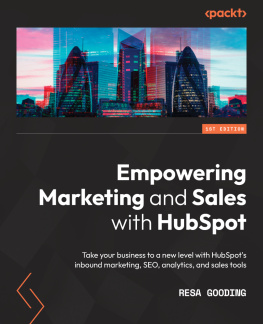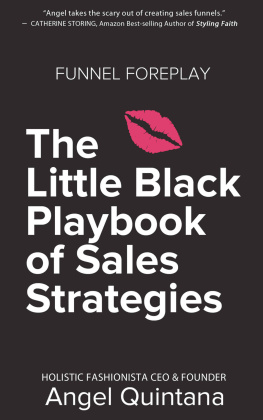THE
LEAKY FUNNEL
HardBits had a strong reputation as an innovator in the supply of the plastic beads used by manufacturers for the production of a range of plastic products. This innovation had earned HardBits the right to command a premium, but this was changing as the beads became a commodity. Faced with the inevitable price pressure of a commodity market, HardBits CEO Frank McInroth set out to gain Board support to purchase a small supplier with a premium product in the belief this would have a knock-on affect on their overall price positioning.
He not only lost his argument with the Board, but also his job. Franks replacement Sue Hunt was hired, not for her leadership of technology, sales or operations, but because she knew how to be a customer.
The Leaky Funnel is the story of Sues journey as she leads her team to uncover and then remove the roadblocks that prevent HardBits from earning new customers.
The metaphor of the funnel has been used by sales management for many years, yet the idea of a funnel that leaks is a twist - if an obvious one. Likewise, The Leaky Funnel draws on both established practice and genuine departure.
The Leaky Funnel is an extremely accessible story, which uses this story of discovery to reveal an innovative approach to planning, managing and benchmarking the Sales and Marketing functions as a co-ordinated resource. The false starts, dead ends, and genuine discovery are dealt with in an easy narrative style. Through Sues clear-headed leadership, the reader is introduced to this innovative planning framework and the many useful management principles that support it.

Copyright Hugh Macfarlane, 2003
This work is copyright. All rights reserved. No part of this book may be reproduced or transmitted in any form or by any means, electronic or mechanical, including photocopying, recording or by any information storage and retrieval system, without prior permission in writing from the publisher.
Published by:
MathMarketing
ABN 14 563 955 163
www.mathmarketing.com
Grateful acknowledgement is made for permission to include the diagram and the related dialogue drawn from Inside the Tornado: Marketing Strategies From Silicon Valleys Cutting Edge . HarperCollins Publishers, Inc., New York, NY, USA, 1995. Included by permission of the author, Geoffrey Moore.
National Library of Australia Cataloguing-in-Publication entry:
Macfarlane, Hugh, 1962- . The leaky funnel : earn more customers by aligning sales and marketing to the way businesses buy. Bibliography. ISBN 978-0-9751354-2-6 1. Marketing. 2. Marketing - Management. 3. Marketing - Decision making. 4. Consumer behavior. I. Title. 658.8
Third edition
Cover and chapter design by PiXEL iNK MEDiA
Contents
Acknowledgements
No idea is entirely original, and this work is no exception. Of what I present in this book, my consulting customers taught me one third, and their clients taught me another third. I thank both for their contribution, and for letting me learn with them; I have had the pleasure of working with some extraordinary people.
The remaining third was taught to me by some great people who share my belief that an idea is not valuable until it has been shared. Amongst this last group I include:
Mary & Mike Molloy from TRB consulting who through their book The Buck Starts Here , and in some workshops I organised in 1997, first introduced (to me at least) the idea of a progressive, granular sales/marketing process that ought to be forecast and measured.
Neil Rackham from Huthwaite Inc. who through his book SPIN Selling presents a clear, well-researched view of the process used by successful sales people to effect progression via discrete and pre-defined advances in the mind of a business buyer.
Alice M Tybout and Brian Sternthal from Kellogg School of Management who in Kellogg on Marketing strip the fluff from market positioning to leave a believable and usable core.
There are also many other great books used in the telling of this story, and these are duly acknowledged throughout and the key ones catalogued as an appendix.
Raw ideas have a value and excitement of their own. To whatever extent the ideas in this book have been proven though, I owe a debt of gratitude to the early adopters of the methodology which this book introduces, now known as Funnelogic (see www.mathmarketing.com ).
In particular, I offer my deep personal thanks to John Ruthven of Computer Associates. At the time of writing, John was Managing Director of the Australian and New Zealand operations of Computer Associates, and he made an early and significant bet on the Funnel Logic methodology, and in the process he, and others in his organisation (especially Marketing Director Jim Fisher), helped to shape it. John and Jim have both since stepped up. At the time of the second printing, John Ruthven is EVP of World-wide Sales Operations, and Jim Fisher is VP of Marketing Asia Pacific Japan.
Finally I must thank the many wonderful friends who offered their wisdom towards the creation and publication of this book. As with any author, I find myself wanting to thank more people than can be done. So I thank you all, particularly those who reviewed the many early drafts and provided insights and feedback.
Three colleagues from MathMarketing helped greatly. Jeff Reid for his strength and encouragement in harder times, and his absolute and constant insistence that I write this book. Paul Miles for his patient review of the first and last drafts, and unrelenting project management of the production of the book and of the Funnel Logic tools which allow users to operationalise the principals introduced in the book. And Peter Philpott for his cogent structural advice with building the argument and its articulation.
Belinda Castles provided highly practical editorial guidance and encouragement, particularly towards the end when, inevitably, the last 20% proved four times as challenging as the first 80%.
Any inconsistencies, omissions or errors that remain in the book are wholly my fault, and are despite the best efforts of these wonderful people.
I am also grateful to Rosemary and Jim for your guidance, Mary for your love and support, and Sophie and Cameron for your hope. Thank you especially for understanding that sharing knowledge is important to me, and for the sacrifices you made to allow me to complete this book.
Dedicated to:
The customers who taught me, and then backed me to teach them a little in return. Be a customer

Sues was an unusual path. Conventional wisdom had it that there were three legitimate paths to becoming CEO of a company that manufactures and markets complex products:
In the early development phases, the ideal leader brought technology leadership;
In the growth phases, a strong sales or marketing leader was needed to accelerate growth;
As the market matured, operational efficiencies became key and the leader was often drawn from law or accounting to bring a tight focus on costs and risk.
Sue Hunt wasnt hired as CEO for any of these reasons.
Sure, she had run successful businesses in previous roles and knew her way around the industry, but this wasnt it either. The Board had decided that their products were good enough, but that was all. In a mature market, customers now viewed the offerings from HardBits and all the other leading vendors as much the same. Despite being founded on leading technology, the market no longer valued this, and HardBits was going to need something other than technology to return it to profitability.
Next page













